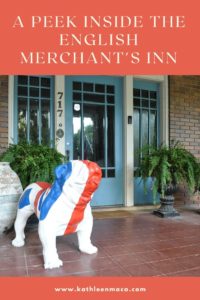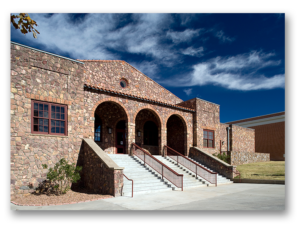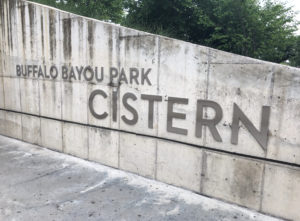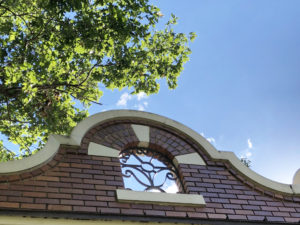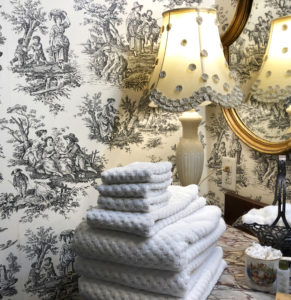Category: Uncategorized
Diggin’ Up Fun at the Museum of the Big Bend
What to do while we’re quarantined? Well, just travel virtually that’s what!
Here’s a link to the instagram visit I had with Matt Walter, Curator of Collections at The Museum of the Big Bend in Alpine, Texas. Just click the link and come along!
Thanks so much, Matt!
O.K, friends – What was your favorite item or exhibit on the tour?
Warm from the Oven: DoubleTree Cookie Recipe
It’s a tradition at DoubleTree by Hilton Hotels to gift guests with a fresh baked cookie at the end of their day. And I’m not one to turn that down! As far as I’m concerned it’s a step up from the traditional “mint on the pillow.”
 But since most of us aren’t traveling right now, Doubletree has kindly decided to share the recipe for their signature cookie so people can treat themselves at home. My kitchen may have gotten a bit messier this evening, but it was SOOO worth it.
But since most of us aren’t traveling right now, Doubletree has kindly decided to share the recipe for their signature cookie so people can treat themselves at home. My kitchen may have gotten a bit messier this evening, but it was SOOO worth it.
If you’d like to try the recipe for yourself here it is, courtesy of Hilton.
DoubleTree Signature Cookie Recipe
Makes 26 cookies
½ pound butter, softened (2 sticks)
¾ cup + 1 tablespoon granulated sugar
¾ cup packed light brown sugar
2 large eggs
1 ¼ teaspoons vanilla extract
¼ teaspoon freshly squeezed lemon juice
2 ¼ cups flour
1/2 cup rolled oats
1 teaspoon baking soda
1 teaspoon salt
Pinch cinnamon
2 2/3 cups Nestle Tollhouse semi-sweet chocolate chips
1 3/4 cups chopped walnuts
Cream butter, sugar and brown sugar in the bowl of a stand mixer on medium speed for about 2 minutes.
Add eggs, vanilla and lemon juice, blending with mixer on low speed for 30 seconds, then medium speed for about 2 minutes, or until light and fluffy, scraping down bowl.
With mixer on low speed, add flour, oats, baking soda, salt and cinnamon, blending for about 45 seconds. Don’t overmix.
Remove bowl from mixer and stir in chocolate chips and walnuts.
Portion dough with a scoop (about 3 tablespoons) onto a baking sheet lined with parchment paper about 2 inches apart. ( I didn’t press my scoops flat like the hotel does, and they cooked just fine.)
Preheat oven to 300°F. Bake for 20 to 23 minutes, or until edges are golden brown and center is still soft.
Remove from oven and cool on baking sheet for about 1 hour.
If the batch of batter seems like more than your household can eat right now, there’s good news. You can freeze the unbaked cookies, and there’s no need to thaw. Preheat oven to 300°F and place frozen cookies on parchment paper-lined baking sheet and cook same as above. Now you can have a fresh, warm cookie whenever the mood strikes you!
The majority of cookies that emerged form my oven are headed to my Dad for Father’s Day, and are definitely going to be a hit.
Pour a glass of milk and enjoy.
Birdwatcher Alert: A Phoenix on Galveston
What’s 15 feet tall with a 35-foot wingspan and gleams in the sunlight? A metal statue of a Phoenix created by Houston based artist Bob Bacon that now guards the gate of his brother’s Galveston ranch.
Bacon’s creation first appeared in the 2017 Houston Thanksgiving Day Parade, after he created it as a post Hurricane Harvey symbol of hope and recovery.
Since it’s big debut, the statue has been nesting in a warehouse, waiting for its next chance to take flight.
 The onset of the coronavirus pandemic inspired the family to install the phoenix on Galveston Island to once again provide a symbol of hope. The Bacon Ranch is an appropriate home for this particular piece of artwork, since most of the land on the ranch has been set aside as grounds for the migrating birds that pass over Galveston Island each year.
The onset of the coronavirus pandemic inspired the family to install the phoenix on Galveston Island to once again provide a symbol of hope. The Bacon Ranch is an appropriate home for this particular piece of artwork, since most of the land on the ranch has been set aside as grounds for the migrating birds that pass over Galveston Island each year.
The family welcomes visitors to pull along the side of the road to get a close look and photos, but asks that no one trespass beyond the fence.
To visit, travel west from Galveston on FM 3005 past Jamaica Beach, and look on the north side of the road.
No binoculars required!
Exploring What Lies Below: Bayou Park Cistern
A cistern….really? If you think that doesn’t sound worth seeing I’m here to tell you it absolutely is!
Thousands of people walk the paths of this beautiful park every day without ever knowing what lies beneath their feet. Let’s go underground and take a peek!
Park your bike or car and step into the visitors center next to this entrance to meet your tour guide. They are part of the Buffalo Bayou Partnership, a non-profit that is restoring the historic Houston waterway, and are so have so much fasc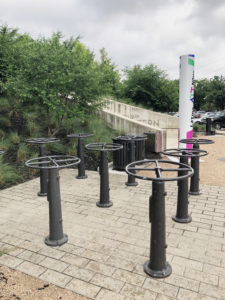 inating knowledge to share and make your visit memorable.
inating knowledge to share and make your visit memorable.
The valve wheels just outside are a good photo opportunity for kids and just fun to play with . . . don’t worry – they aren’t connected actually to anything any more. They used to be stationed around the perimeter of the cistern to allow the water flow to be turned off when the cistern was full.
Following your guide through the metal doors you’ll walk through a poured concrete corridor to one last metal, sliding door.
Stepping inside the cistern you’ll be greeted with a view that seems more grand than functional. It’s the columns – row after row – that together create a sense of being in some sort of exotic Roman underground grotto rather than just a few steps from Houston sunshine.
The expanse that visitors take in includes 221 columns, 165 of which are are 25 feet tall. They stand stoically in a cavernous space of over 87,500 square feet – about a football field and a half in size. When filled to capacity the cistern could hold 15 million gallons of water standing within six inches of the ceiling.
The water plant where the contents would drain used to be where the nearby Aquarium Restaurant stands today.
A comfortably wide walking path with metal railings surrounds the water storage area allowing access around the entire perimeter.
The cistern was built in 1926 as an underground drinking water reservoir for the city by Standard Construction Company, and took 95 days to construct in a pre-excavated site. Over 6,000 cubic yards of concrete and over 800,000 pounds of reinforcement steel were used. Half of that alone went into the 8″ thick ceiling that tops walls that are 8″ thick at the at top widening to 18″ at the bottom.
On your tour you’ll hear about the challenges of obtaining water in the early days of Houston for uses such as putting out fires led to decisions that ultimately building the infrastructure that included the cistern. If you normally think talking about history is pretty dry, well . . . this story’s all wet. (Sorry!)
In 1926 the cistern was called the City of Houston 15 Million Gallon Covered Reinforced County Reservoir. Today’s name of The Buffalo Bayou Park Cistern is sure easier to remember!
There wasn’t always an entrance tunnel to the space. On each of the four sides there is a 50-pound hatch in the ceiling with a ladder extending down into the cistern, and a concrete stairway down to the water. Maintenance workers would have had to navigate the wet ladder and climb down to balance on what used to be a two-foot ledge before proceeding to the stairs, carrying only a dim lantern to guide them. Makes me wonder how many lost their footing and ended up in the water!
The small amount of water now provides a beauty and esthetic quality as well as moisture that helps maintain the concrete of the structure. We all need a bit of “maintenance,” don’t we – and the cistern will be 94 years old this summer!
In 2010 the City of Houston was searching for a contractor to demolish the decommissioned cistern when members of the Buffalo Bayou Park project “discovered” the site. Seeing its historical significance, they took over the cistern and had it restored.
 And now for my favorite part of the tour: turning off the lights! Yes, it’s definitely a bit spooky, and this is when you realize how happy you are that your guide was carrying such a large-faced flashlight. As the lights shut off, you’ll experience the very definition of dark!
And now for my favorite part of the tour: turning off the lights! Yes, it’s definitely a bit spooky, and this is when you realize how happy you are that your guide was carrying such a large-faced flashlight. As the lights shut off, you’ll experience the very definition of dark!
Watching as the wide beam from your guide’s light is directed in different ways, it’s fascinating to see the illusions it creates.
Today the water at the base of the columns is only about eight or nine inches deep, but light on the water gives the illusion of the columns being twice as tall and the water much deeper than it truly is.
As the guide shines the light toward one specific point, the vision of the columns seems to stretch into infinity. It’s truly breathtaking.
Now if you’re as lucky as I was, you will be assigned one of the talented guides who happens to have a beautiful singing voice. Hearing the songstress’ a cappella performance reverberate around the cistern was awe inspiring. The water, concrete walls, columns and their symmetrical placement create an echo that lasts 17 to 20 seconds, and audibly seems to travel around the area.
The Park group recently hosted their first two projected light art installations by artists, and hope to offer a third this fall. It’s a wonderful way to take advantage of this unique space.
Thanks to a permanent installation named “Down Periscope” by artist Donald Lipski, you can take peer below even if you aren’t on a tour. Visitors to the park above the cistern can use the periscope to see what’s going on below. If you’re further away, it can be viewed and controlled online. Just click this link to take a look. (NOTE: during the current quarantine, the periscope isn’t operational online or in person.)

Buffalo Bayou Park’s cistern is the only defunct reservoir of its size open to the public in the United States. The closest thing in stature is the Basilica cistern in Istanbul, Turkey which was made around 500 A.D.
It’s one of the few magnificent views in the city that doesn’t depend on the weather.

Walking tours of the cistern are available between 10:30 a.m. and 4:30 p.m. Mondays, Tuesday and Wednesdays and last for about 15 minutes. They’re given on a first-come first served basis and only cost $5.
Longer private tours for larger groups (great for photographers and history enthusiasts) are available as well and can be booked online here.
Be sure to check their website ahead of time for rules and restrictions that may affect your visit.
See you beneath the city!
Texas’ First White House: The Ross Sterling Mansion
This morning I posted a photo and bit of information about the Ross Sterling Mansion, which is known locally as the First Texas White House. After receiving several messages asking for a bit more information, I’m sharing it here.
This beauty is right down the road from my own home…which is decidedly smaller!
Architect Alfred C. Finn designed the scaled down replica of the American White House for Humble Oil founder and future Texas governor Ross Sterling. It’s a Texas State Historical Landmark as well as being listed on the National Register of Historic Places.
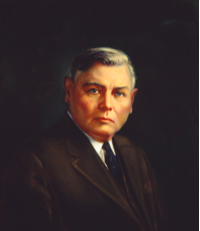
Finn, by the way, also designed Houston’s Jefferson Davis Hospital, Sam Houston Coliseum, and the San Jacinto Monument in addition to numerous other federal and private projects.

 Construction on the grand residence began in 1924 and was completed in 1927. First named “Miramar” – meaning “sea view” – the 21,000 square foot mansion sits on six about six and a half acres of residential coastline between La Porte and Morgans Point.
Construction on the grand residence began in 1924 and was completed in 1927. First named “Miramar” – meaning “sea view” – the 21,000 square foot mansion sits on six about six and a half acres of residential coastline between La Porte and Morgans Point.

Its 34 rooms include nine bedrooms, 15 baths, a dining room that seated 300 guests, a ballroom with pressed tin ceiling and marble fireplace, a gentleman’s lounge with carved wood fireplace and built-in leaded glass-front bookcases, a mahogany-paneled library, a ladies’ parlor, and a kitchen with butler’s pantry. Seven fireplaces warmed the waterfront home on chilly winter evenings, and the rooftop terrace still offers stunning 360-degree waterfront views.

This pair of serpentine reversed staircases in the foyer would put the most stunning movie set to shame.

The waterfront side of the home features a 28-foot columned rotunda portico that most people immediately recognize as being based on the White House.


The staircases and lowest level are made of granite blocks, and the walls of the upper stories are made of foot-thick limestone. The foundation is reportedly strong enough to support a ten-story building. The stalwart structure has withstood countless storms including Carla, Alicia, and Ike. I would certainly feel safe within its walls!

Ross Sterling was the 31st governor of Texas, serving from 1931-1933. Countless dignitaries and celebrities have been hosted in the home over the years.

Sterling and his wife Maude Abbie Gage had several children, and they along with a generation of grandchildren enjoyed the home for two decades.

In 1946 he donated his mansion to a civic club and it was used as a juvenile home until 1961. During those years the home suffered heavy damage.

Thankfully a handful of owners in the interim years have restored it to its former glory. It still retains many of the original features including intricately carved and gilded moldings, silver and gold light sconces, Tiffany chandeliers, antique stone fireplaces, pressed-tin ceilings and marble and oak flooring.
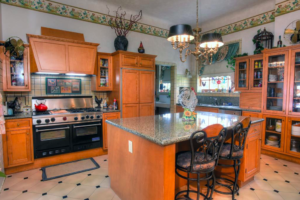
It is now once again a private residence, having sold at auction in 2016 for $2.8 million (though initial estimates were for $4 million).
If the current owners insisted on having me over for tea, I must admit I wouldn’t mind!
If you’d like to cruise by on a Sunday drive, the historic home is located at 515 Bayridge Road in LaPorte.

Click the links below to watch some entertaining home movies shot at the mansion back in it’s Fitzgerald-era heyday!





Waxahachie’s Bit of Britain: English Merchants Inn
NOTICE: This trip was taken before the Corona virus quarantine.
Mother-daughter weekend getaways with my teenager are a gift, and we recently discovered an inviting bed and breakfast that was the perfect home base for our exploration of the charming town of Waxahachie.
The last thing you might expect to find in this small town just 30 miles south of Dallas are British theme lodgings, but you won’t want to miss experiencing the British Merchant’s Inn for yourself.
Owners Mary and Howard Baskin have been lucky enough to live in the red brick Mission style bungalow style home twice. They raised their family there before moving away for several years, and then re-purchased it in 2016 to turn it into a bed and breakfast.
 At the end of a long drive from Houston my daughter and I were relieved to pull into a parking space on the side of the inn, which sits on a lovely residential stretch of West Main Street. After being greeted at the door by a large concrete bulldog painted with the Union Jack we stepped inside, and into an explosion of creative interior design with a nod to the British Isles.
At the end of a long drive from Houston my daughter and I were relieved to pull into a parking space on the side of the inn, which sits on a lovely residential stretch of West Main Street. After being greeted at the door by a large concrete bulldog painted with the Union Jack we stepped inside, and into an explosion of creative interior design with a nod to the British Isles.
If every corner you see appears to be a picture perfect vignette, there’s a good reason. Mary worked as an interior designer for over 35 years and produced interior design articles for publications such as Traditional Homes, Country Home and Better Homes and Gardens as a regional editor for Meredith Publishing.
She also organizes small group antique shopping trips abroad – which I’d love to take part in now that I’ve witnessed her knack for finding such unique items. Her delightfully amusing discoveries fill every room at the BnB.
The home, whose layout is ideal for operating an inn, was built and occupied by James Wright Harrison by 1910 (according to the census), although the owner’s obituary stated that he built it in 1905.
James was born in Arkansas and came to Texas in 1868 when he was just 12, with his British born father, American mother and a houseful of siblings.
Later, the cotton farmer married an English girl named Fanny and they moved into this home in town where they lived the rest of their lives, passing away just one day apart in 1944.
Though they never had children, I’m pretty sure their love story lives on in the walls of their beautiful home.
 Mary took the opportunity to incorporate her love of England to reflect the heritage of the original homeowners, and create an inviting place where guests can recharge between jaunts into town to take in the sights.
Mary took the opportunity to incorporate her love of England to reflect the heritage of the original homeowners, and create an inviting place where guests can recharge between jaunts into town to take in the sights.
We stayed in an upstairs Room 1, which offered two separate beds. My daughter immediately chose the one nestled beneath a window and piled with pillows.
My larger bed was beneath a crystal chandelier in another nook of the room, providing us both with a sense of togetherness, with a bit of privacy.
Each of the guest rooms has a private bathroom in which the Baskins have provided all the necessities down to fluffy towels and make-up remover. My daughter and I were determined to enjoy the large claw foot tub during our stay (although we used the shower more often), so we stopped by a local drugstore and treated ourselves to fragrant bath bombs. (Because it wouldn’t be a girls’ weekend without a bit of pampering, right?) Ooh-la-la!
Mary invited us to explore the other rooms to statisfy our curiosity, and each was a unique little oasis of comfort and style.

Room #3 featured a very British, very red bathroom with walls adorned with antique hats.
The romantic canopy bed in room number 2 is perfect for couples or just to treat yourself. The room features its own private second floor patio balcony.
The only downstairs guest room, number 4, is the largest and features boldly striped walls.
A “formal” downstair parlor and bar areas, complete with grand piano, are also on the ground floor and would make an ideal place to meet up with your traveling friends who may not have been lucky enough to stay at the inn.
Our mornings began with cups of tea sipped from china cups while we were getting ready for the day. My daughter loved visiting the “tea station” in the mornings and evenings and choosing a different floral china cup to use…and I admit so did I.
For breakfast we were given vouchers for an adorable nearby café called the White Rhino Coffee + Kitchen. Conveniently close to the inn it had plenty of parking and delicious food. I hate to think that I may have missed this gem if Mary hadn’t sent us there! Located in an old two-story home, the downstairs has been renovated and opened into large comfortable spaces that encouraging lingering. And, um…the cinnamon rolls served in individual mini skillets? Yes, please! The staff was just as enchanting as the food and restaurant itself, so we were glad to be able to revisit them two days in a row.
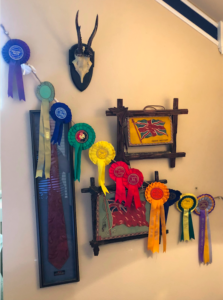 Anyone who thinks there wouldn’t be enough to do around this small town needn’t worry. We spent hours in the antique shops and chatting with the friendly owners, searched for and found all of the “Hachie Hearts” (read more about them HERE), had a yummy sandwich and malt for lunch at Farm Luck (an old fashioned soda fountain that is a “must”), photographed the old railroad station and bridge, and Art on the Square where we enjoyed chatting with a local artist patiently creating a new masterpiece.
Anyone who thinks there wouldn’t be enough to do around this small town needn’t worry. We spent hours in the antique shops and chatting with the friendly owners, searched for and found all of the “Hachie Hearts” (read more about them HERE), had a yummy sandwich and malt for lunch at Farm Luck (an old fashioned soda fountain that is a “must”), photographed the old railroad station and bridge, and Art on the Square where we enjoyed chatting with a local artist patiently creating a new masterpiece.
The recently restored courthouse on the square in town has quite a legend attached to it, that you can read more about HERE.
Movie buffs may recognize several sights around town used as movie backdrops for films that include “Bonnie and Clyde,” “Tender Mercies” and “Places in the Heart.” And the friendly hosts of the English Merchant Inn are more than happy to cue up one of these classics for you to enjoy in the TV room as you put up your feet after a long day of walking from shop to shop.
 If you aren’t in the mood for movies, you may want to pull up a chair to the den table to work on a puzzle or curl up with one of the numerous books from the shelves guests are invited to enjoy.
If you aren’t in the mood for movies, you may want to pull up a chair to the den table to work on a puzzle or curl up with one of the numerous books from the shelves guests are invited to enjoy.
I couldn’t help but think how fun it would be to stay at the inn with a group of friends, taking over the entire second floor and enjoying the common spaces together, or sitting on the wide porch watching the rest of the world go slowly past.
I think it’s the perfect “excuse” to visit again, don’t you?


Oh My Stars! A New View of the Night Sky
Starry, starry night . . .
Wherever we are . . . at home or on far flung travels . . . the night sky offers a brilliant show just waiting for us to take notice.
 When I was in west Texas recently, far from the “light pollution” of urban areas, I was reminded that the sky actually more resembles a spilled pot of glitter than an occasional point of light. It was one of those times that I wished I knew how to identify the different stars and constellations. That’s something I have always meant to learn more about when I “had the time.”
When I was in west Texas recently, far from the “light pollution” of urban areas, I was reminded that the sky actually more resembles a spilled pot of glitter than an occasional point of light. It was one of those times that I wished I knew how to identify the different stars and constellations. That’s something I have always meant to learn more about when I “had the time.”
When relating to a friend how awestruck I was at the beauty of the sky on that trip, he suggested that I download an app called SkyView Lite, a free version of an application that creates a kind of overlay of the sky as you hold it up. It identifies stars, planets, constellations and more. Once I tried it I was hooked! Even back home on nights that had too much cloud cover to see many twinkly heavenly bodies, it shows me where they’re positioned. Touch a point of light on your phone screen and it will identify it by name, show its trajectory and even give interesting trivia about it.
 There is a paid version of this app with more features, but honestly for now I’m finding plenty of enjoyment with the free version. It’s fun to use with friends, family or just by yourself as you sit beneath the endless sky enjoying how vast creation can be.
There is a paid version of this app with more features, but honestly for now I’m finding plenty of enjoyment with the free version. It’s fun to use with friends, family or just by yourself as you sit beneath the endless sky enjoying how vast creation can be.
When was the last time you took the opportunity to star gaze?
Watch a video demo here.
Officially Texas
I love sharing places to visit across the Lone Star State through this blog, but I hope we’re all being responsible at the moment by staying at home and being healthy. When the Corona virus threats retreat, we’ll all be ready to get out and be social again.
In the meantime, it doesn’t mean we can’t explore Texas!
This morning I was remembering how when my daughter wasn’t quite school age yet, and it was pretty much a full time job to keep her busy little mind occupied and entertained. One of the things we did was talk about how Texas had all kinds of “official” symbols. How many do you know?
Official flower: Bluebonnet
Official large mammal: Longhorn
Official sport: Rodeo
Official Dish: Chili con carne
Official Insect: Monarch Butterfly
Reptile: Horned lizard
Tree: Pecan
Plant: prickly pear cactus
Air Force: Commemorative Air Force (formerly know as the confederate Air Force)
Amphibian: Texas toad
Aquarium: Texas State Aquarium
Bison Herd: Texas State Bison Herd at Caprock Canyons State Park
Bluebonnet Festival: Chappell Hill Bluebonnet Festival
Bluebonnet Trail: Ennis
Bread: Pan de campo
Cobbler: Peach cobbler
Cooking implement: Cast iron Dutch oven
Crustacean: Texas Gulf shrimp
Dinosaur: Paluxysaurus Jones (replace the Brachiosuar in 1997)
Dog breed: Blue Lacy
Epic Poem: Legend of Old Stone Ranch
Fiber and Fabric: Cotton
Fish: Guadalupe Bass
Footwear: Cowboy boot
Fruit: Texas Red grapefruit
Botanical Garden: Lady Bird Johnson Wildflower Center
Gem: Texas blue topaz
Gemstone cut: Lone Star cut
Grass: Sideoats grama
Official Domino Game: 42
Horse: American Quarter horse
Flying Mammal: Mexican Free-Tailed bat
Small Mammal: Armadillo
Maritime Museum: Texas Maritime museum
Motto: “Friendship”
Musical Instrument: Guitar
Native Pepper: Chiltepin
Native Shrub: Texas Purple Sage
Shrub: Crape myrtle
Snack: Tortilla chips and salsa
Song: “Texas, Our Texas”
Pastries: (there are 2!) Sopapilla and Strudel
Pepper: Jalapeno
Pie: Pecan pie
Pollinator: Western honey bee
Precious Metal: Silver
Railroad: Texas State Railroad
Rodeo Drill Team: Texas Ghost Riders
Saltwater Fish: Red Drum
Sea Turtle: Kemp’s Ridley sea turtle
Shell: Lightning whelk
Ship: U.S.S. Texas
Squash: Pumpkin
Stone: Petrified palmwood
Tall Ship: Elissa
Vegetable: Sweet onion
Vehicle: Chuck wagon
And believe it or not . . . there are SO many more!
For each of the symbols, you and your child can explore information online about what makes these things so very Texan.
Make chili con carne for dinner, and follow it with pecan pie and a domino game of 42. (How to play here.)
Print coloring sheets with some of the symbols. 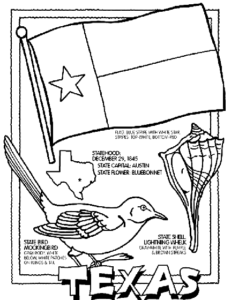
Plant your own butterfly garden to attract monarchs. My daughter and I still care for our ever larger Monarch garden that we created 15 years ago, and watching the life cycle of these beautiful creatures never gets old. (Everything you’ll need is here.)
Make columns on a poster board and have your child help you separate some of these by category (place, animals, etc.)
Make a list of “official” sites you’d like to visit when travel limitations are lifted. (The tall ship Elissa in Galveston, a ride on the Texas State Railroad, etc.)
But most importantly have fun and share the love of Texas. What is your favorite Lone Star State (the official Texas nickname) symbol?
Free Fossil Hunting in Mineral Wells…Can Ya Dig It?
When I was a kid I wanted to be an archaeologist when I grew up.
Now mind you, this was in the days (dark ages) before the Indiana Jones movies, so my parents didn’t quite know what to do with this aspiration, other than try to direct me elsewhere.
I’ve never quite gotten over my fascination with archaeological dig sites, and recently I went to the Mineral Wells Fossil Park where visitors can dig for and keep fossils over 300 million years old!
Think of it as the fossil equivalent of searching for seashells along a beach.
 Mineral Wells Fossil Park is a primitive, unique site that’s a fascinating place to explore by yourself or with your family. Offering eight acres to comb, the park used to be the city’s “borrow pit,” which is an area where dirt is taken from to fill other areas. The resulting pit eroded over the 20 years it was used, exposing thousands of fossils from the Pennsylvanian Period.
Mineral Wells Fossil Park is a primitive, unique site that’s a fascinating place to explore by yourself or with your family. Offering eight acres to comb, the park used to be the city’s “borrow pit,” which is an area where dirt is taken from to fill other areas. The resulting pit eroded over the 20 years it was used, exposing thousands of fossils from the Pennsylvanian Period.
It’s one of the few parks in the nation where visitors are legally allowed to remove fossils from the site, taking home true treasures.
There is plenty of parking in the gravel parking lot, where you’ll also find clean, portable toilets, but no running water. If you’re going to want to wash your hands or rinse off a bit after your outing before you re-enter your car bring an extra jug of water.
Take time to read the informational signs in the parking lot. They’ll help you to identify things you might otherwise overlook.
If you’d like to take along a “cheat sheet” click this link to find a handy, printable reference sheet of fossil types, courtesy of fossilcentre.com.
The park is primitive in more ways than one. You may encounter dangerous insects or animals (it IS their turf, after all) so keep a sharp eye out for them. And once you descend into the pit, don’t expect your cell phones to work. See? Magic – time travel.
Follow the path to the pit (there’s one way in and one way out to minimize damage to the site). A chain handrail will help steady your balance on the rocky soil as you follow the walkway into the search area.
My visit was on a day after a light rain which was ideal, since it washed the top layer of dust off of things and revealed new items in the channels where water runs down the sides of the pit. I had been told that I wouldn’t really need to “dig” for the fossils since most of them would be laying right on the surface, but I was skeptical. I was wrong . . . and it was amazing.
 You might find fossils of ancient sea species like trilobites, crinoids (urchins), brachiopods, pelecypods, (clams and oysters), corals, plants, and even sharks.
You might find fossils of ancient sea species like trilobites, crinoids (urchins), brachiopods, pelecypods, (clams and oysters), corals, plants, and even sharks.
The type I found with the least effort were sea lilies (which sound much more impressive when referred to as crinoids). Sometimes called  “Indian beads” or “Indian buttons” (what my great-aunt used to call them) in reference to their button or bead-like shape, people used to collect and string them into necklaces. Not to get to “science-y”, but this illustration will show you what where in the plant (columnal) they were originally. Fossils from the other parts of the plant can be found as well.
“Indian beads” or “Indian buttons” (what my great-aunt used to call them) in reference to their button or bead-like shape, people used to collect and string them into necklaces. Not to get to “science-y”, but this illustration will show you what where in the plant (columnal) they were originally. Fossils from the other parts of the plant can be found as well.

